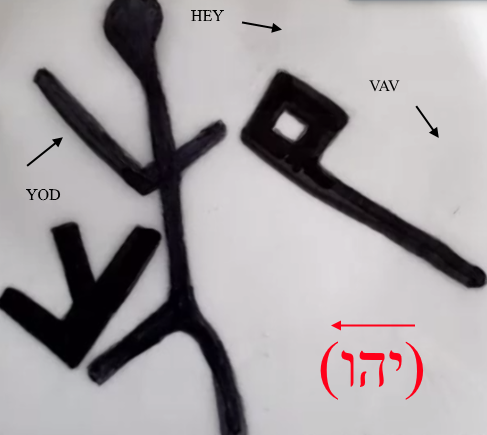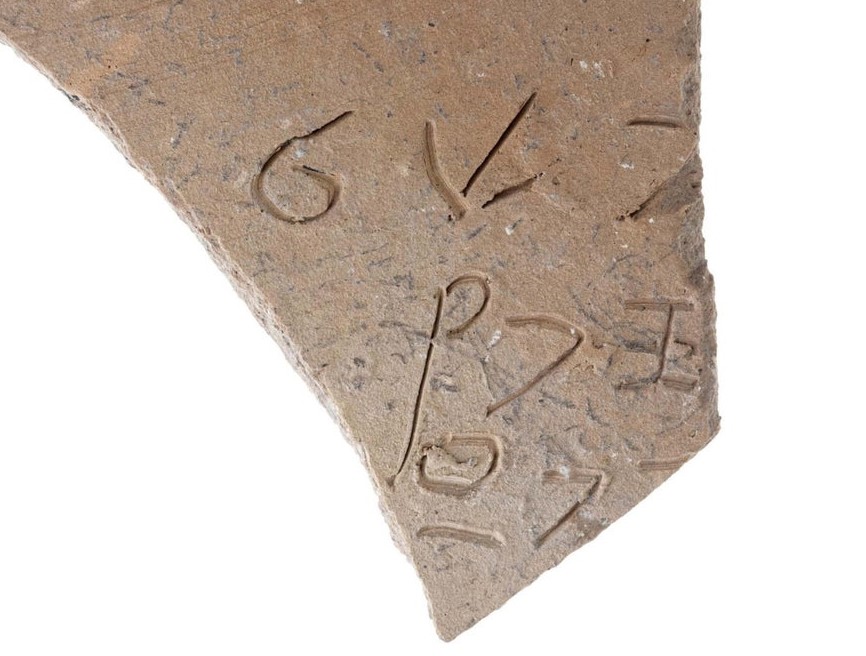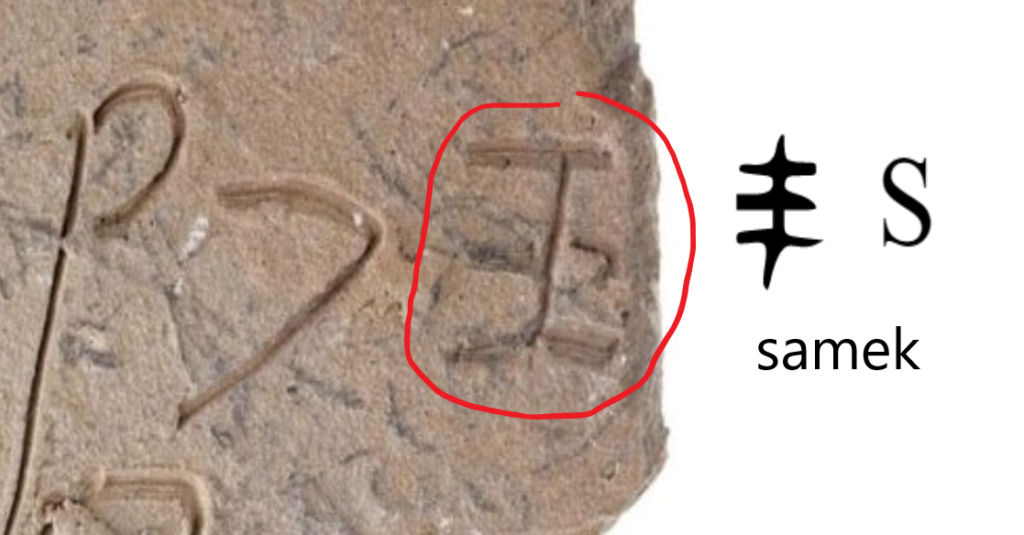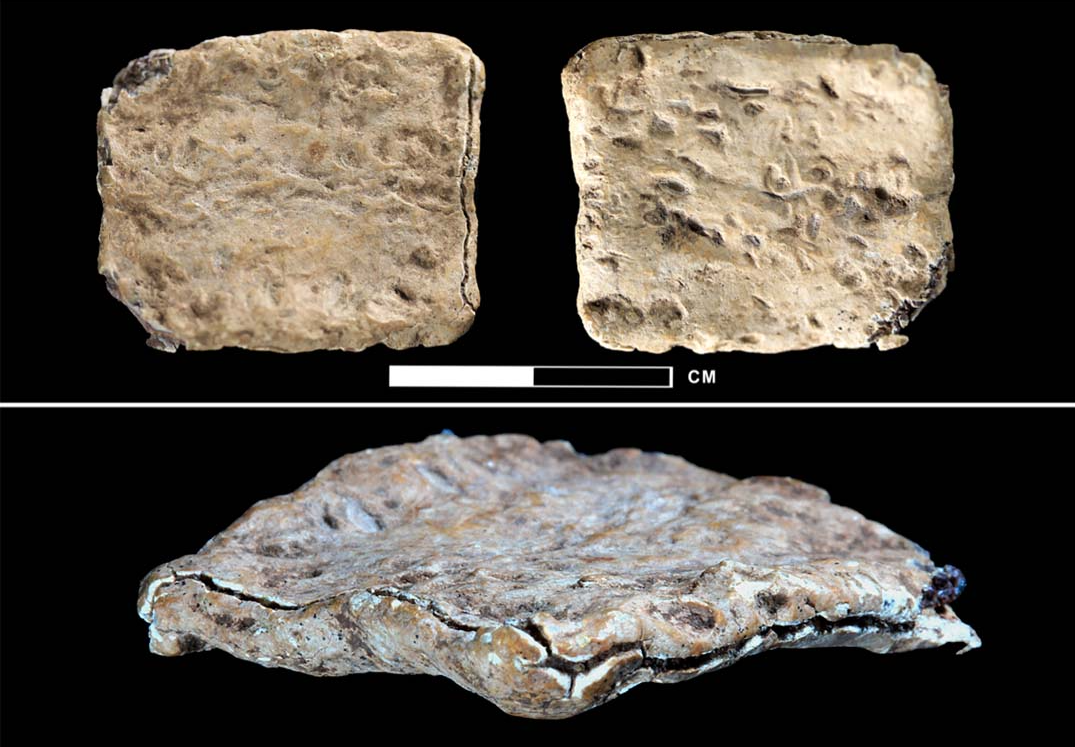About the Mt. Ebal Curse Inscription
In 2019 a large “dump” of excavated material from the 1980s was sifted through for discovery of any archaeological remains. That material had been sifted through already but was only dry sifted. A newer technique called wet sifting had proven to be very effective at other sites like Shiloh so in 2019 the contents from Mt. Ebal were wet sifted and to say the effort paid off is the understatement of the century.[1]https://www.timesofisrael.com/archaeologist-claims-to-find-oldest-hebrew-text-in-israel-including-the-name-of-god/
Found in the wet sift was a lead tablet that might remind our readers of another metal-based ancient inscription known as the Ketef Hinnom scrolls. The document was folded so the text was on the inside and unreadable. Some characters appear to be on the outside but are difficult to make out and have yet to be published. Given that the amulet was made of lead, it was thought that electron scanning, which was used to read a number of folded or curled Dead Sea scrolls, would be ineffective. However, with the modern scanning technology the text was indeed able to be read and even readable. The text of the inscription is not completely published and is still awaiting peer review but a version in English has been released by the Associates for Biblical Research. The script itself is in Proto-Canaanite (AKA Proto-Sinaitic) which was the predecessor to Paleo-Hebrew.
The curse etched on this lead tablet reads in a chiastic form.
Cursed, cursed, cursed
—Cursed by the god YHW.
——You will die cursed.
——Cursed you will surely die.
—Cursed by YHW
Cursed cursed cursed.(An English translation of Prof. Gershon Galil)
The text of the curse might be overlooked as being unimportant because it does not contain any biblical material. However, this piece all but confirms the curse placed on Mt. Ebal in Deuteronomy 27 and Joshua 8.
When you have crossed the Jordan, these tribes shall stand on Mount Gerizim to bless the people: Simeon, Levi, Judah, Issachar, Joseph and Benjamin. 13 And these tribes shall stand on Mount Ebal to pronounce curses: Reuben, Gad, Asher, Zebulun, Dan and Naphtali.
14 The Levites shall recite to all the people of Israel in a loud voice:
15 “Cursed is anyone who makes an idol—a thing detestable to the Lord, the work of skilled hands—and sets it up in secret.”
Then all the people shall say, “Amen!”16 “Cursed is anyone who dishonors their father or mother.”
Then all the people shall say, “Amen!”17 “Cursed is anyone who moves their neighbor’s boundary stone.”
Then all the people shall say, “Amen!”18 “Cursed is anyone who leads the blind astray on the road.”
Then all the people shall say, “Amen!”19 “Cursed is anyone who withholds justice from the foreigner, the fatherless or the widow.”
Then all the people shall say, “Amen!”20 “Cursed is anyone who sleeps with his father’s wife, for he dishonors his father’s bed.”
Then all the people shall say, “Amen!”21 “Cursed is anyone who has sexual relations with any animal.”
Then all the people shall say, “Amen!”22 “Cursed is anyone who sleeps with his sister, the daughter of his father or the daughter of his mother.”
Then all the people shall say, “Amen!”23 “Cursed is anyone who sleeps with his mother-in-law.”
Then all the people shall say, “Amen!”24 “Cursed is anyone who kills their neighbor secretly.”
Then all the people shall say, “Amen!”25 “Cursed is anyone who accepts a bribe to kill an innocent person.”
Then all the people shall say, “Amen!”26 “Cursed is anyone who does not uphold the words of this law by carrying them out.”
Then all the people shall say, “Amen!”(Deuteronomy 27:12-26)
Then Joshua built on Mount Ebal an altar to the Lord, the God of Israel, 31 as Moses the servant of the Lord had commanded the Israelites. He built it according to what is written in the Book of the Law of Moses—an altar of uncut stones, on which no iron tool had been used. On it they offered to the Lord burnt offerings and sacrificed fellowship offerings. 32 There, in the presence of the Israelites, Joshua wrote on stones a copy of the law of Moses. 33 All the Israelites, with their elders, officials and judges, were standing on both sides of the ark of the covenant of the Lord, facing the Levitical priests who carried it. Both the foreigners living among them and the native-born were there. Half of the people stood in front of Mount Gerizim and half of them in front of Mount Ebal, as Moses the servant of the Lord had formerly commanded when he gave instructions to bless the people of Israel.
34 Afterward, Joshua read all the words of the law—the blessings and the curses—just as it is written in the Book of the Law.
(Joshua 8:30-34)
Perhaps the most important aspect of this discovery is the oldest known (presumably Israelite) occurrence of the divine name of YHW/YHWH. The name occurs twice. If the artifact is confirmed to be dated from the Late Bronze Age (c. 1550–1200 BC), then it would be competing as the oldest known YHW inscription, alongside the Shasu of Yhw (nomads of YHW) inscription. Besides these two, the next oldest is hundreds of years later. These two inscriptions prove that the cult worship of YHW was in both the southern Levant and northern Levantine regions. Mt. Ebal is in the center of northern Canaanite territory and the Shasu of Yhw inscription is a hieroglyph from Egypt but refers most likely to southern dwelling Canaanites such as Moses’ father-in-law who was from Midian. The Shasu are also found in the Moabite regions. Thus, the newly discovered inscription is the oldest one in a language that was used in Israel or Canaan.

Why this is such a big deal
It has been believed by modern archaeology that any kind of cohesive Israelite identity was a late development that emerged locally (not from an exodus) and that any Israelites that might have existed in the Levant during the LBA lacked the writing ability to comprehensively document the laws given to Moses or the biblical stories. This script at Ebal seems to alleviate both concerns. The Ebal inscription appears to demonstrate that the Israelites had a written language that was both sophisticated and Semitic. To what extent the literacy rates allowed people to read this language is unknown. The fact that the discovered text appears to be satisfying the commands in the biblical narrative means that it’s likely an Israelite inscription and not a Canaanite one.
Does this prove that early Israelites were in the land or that a YHW cult existed there before the Israelite identity formed?
It is easy to assume that since there is an inscription located in an Israelite territory that is written in a presumed Israelite language and mentions the Israelite god, that this must mean that Israelites were in the land. However, it is also possible that this artifact demonstrates a widespread cult of YHW that predates the exodus event. Archaeology has already demonstrated that the cult of YHW had noticeable cross-over with Canaanite religion (see: Kuntillat Ajrud). However, instances of Yahwism mixing with Canaanite religion is all over the Old Testament. Archaeological evidence of such syncretism is also from a later period, long after the Exodus. This would point towards Yahwism slowly supplanting Canaanite religion, not that the two share an ancient past together.
Does this confirm an early Exodus?
The dating of this piece will determine the question to the answer. Proto-Sinaitic script was thought to be used between the 17th-15th centuries. If true, then it would be strange to see it still in use in the 13th or even 12th centuries. Moreover, we know that other languages were in use during the 13th and 12th centuries. A recent pot shard discovered in Lachish that dates from the 12th century clearly shows a Canaanite script in use that was Phoenician/Canaanite which is far removed from the semi-pictographic letters of the Proto-Sinaitic script. The Phoenician script was developed during the 14th/13th century and became the primary script in Canaan from c. 1200-800 BCE.


If we accept that the curse inscription at Mt. Ebal is both Israelite and 14th century then it will be very difficult to hold a late date for the Exodus. Of course, it’s possible that this was not done by an Israelite and that the biblical story was tapping into an older Canaanite tradition whereby Mt. Ebal was used to cast curses. Thus, the command to use the mount to curse may not have been a novel command to Joshua and the people.
Full Presentation
For those wishing for more detailed information and some visuals, I recommend you check out the unveiling by Associated for Biblical Research (ABR).
References
| ↑1 | https://www.timesofisrael.com/archaeologist-claims-to-find-oldest-hebrew-text-in-israel-including-the-name-of-god/ |
|---|

So… no pictures of the actual inscription? Sounds suspicious…
I included a few of the snippets of them in the article. They are not finished publishing the information. Give it time. They will publish images, transliterations, and translations. Archaeology is a slow process.